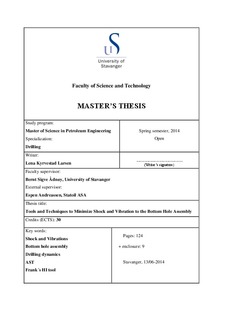| dc.contributor.author | Larsen, Lena | |
| dc.date.accessioned | 2014-09-22T12:31:06Z | |
| dc.date.available | 2014-09-22T12:31:06Z | |
| dc.date.issued | 2014-06-13 | |
| dc.identifier.uri | http://hdl.handle.net/11250/220906 | |
| dc.description | Master's thesis in Petroleum engineering | nb_NO |
| dc.description.abstract | When drilling a well there is a risk of serious damage caused by drillstring vibrations. Shock and vibration are identified as a cause of premature failure on drill bit and components in the bottom hole assembly (BHA), resulting in lost time for operators and costing service companies several millions in repair each year. The expenditures incurred by drillstring vibrations include reduced rate of penetration (ROP), tripping and poor drilling performance. Currently, several tools and techniques are used in the attempt to minimize shock and vibration. For vibration mitigation to be more effective in the future, the most effective tools and techniques must be designated, implemented and improved.
The main objectives of this thesis are to give an insight into the main vibration problem and determine effective mitigation tools and techniques, with regards to the BHA design, which can minimize shock and vibration, and improve the drilling performance in the future. A particular focus was given to anti-vibration tools, and vibration prevention in underreamer applications. The thesis is divided into four main parts; theory on drillstring vibrations, evaluation of various tools and techniques for vibration mitigation, including supplier input, a performance analysis of the Anti Stick-slip Technology (AST) and finally a discussion and conclusion part. Several field case studies are presented to illustrate how the tools and techniques can reduce the risk of detrimental vibrations.
The work is based on literature reviews and is substantiated by comparative field experiences. Additional information was acquired through conversations with Statoil, the directional drilling suppliers and tool suppliers. These conversations proved highly valuable and resulted in several proposed tools and techniques that should be considered when designing the BHA.
The thesis revealed that BHA design awareness can lead to huge advancements in terms of minimizing shock and vibration. Roller reamers should be added to the assembly if high stick-slip levels are expected or if the stabilizers experience extensive friction. Anti-vibration tools, such as AST and Frank´s Harmonic Isolation (HI) tool should be considered, as field experience indicates that these tools can reduce the vibration level. The results of the AST performance analysis indicated a 21% increase in ROP for runs including the tool. For underreamer operations a great potential exists in placing an expandable stabilizer above the underreamer. Another BHA alteration that should be considered is tapered stabilization, which can lead to fewer twist-offs in large hole sections. In the future, the industry must be willing to make changes in order to minimize shock and vibration. A constant push towards better procedures and innovative technology is needed. | nb_NO |
| dc.language.iso | eng | nb_NO |
| dc.publisher | University of Stavanger, Norway | nb_NO |
| dc.relation.ispartofseries | Masteroppgave/UIS-TN-IPT/2014; | |
| dc.rights | Attribution-NoDerivs 3.0 Norway | * |
| dc.rights.uri | http://creativecommons.org/licenses/by-nd/3.0/no/ | * |
| dc.subject | petroleumsteknologi | nb_NO |
| dc.subject | boreteknologi | nb_NO |
| dc.subject | shock and vibrations | nb_NO |
| dc.subject | bottom hole assembly | nb_NO |
| dc.subject | drilling dynamics | nb_NO |
| dc.subject | frank's hi tool | nb_NO |
| dc.title | Tools and techniques to minimize shock and vibration to the bottom hole assembly | nb_NO |
| dc.type | Master thesis | nb_NO |
| dc.subject.nsi | VDP::Technology: 500::Rock and petroleum disciplines: 510::Petroleum engineering: 512 | nb_NO |

